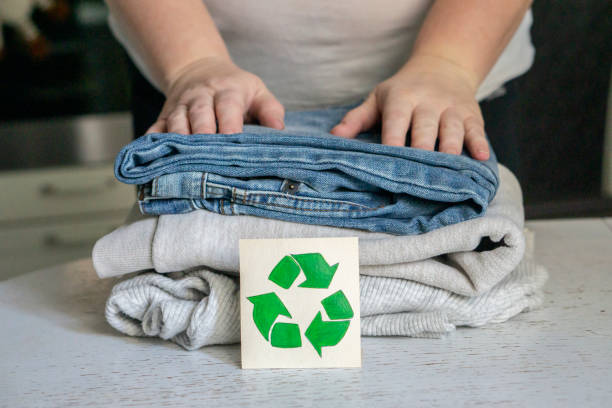Sustainable fashion is more than just a trend; it’s a movement towards a more eco-friendly, ethical, and responsible way of creating and consuming clothing. In this article, we’ll explore six eco-friendly materials that can make a significant impact on reducing your wardrobe’s carbon footprint.
1. Organic Cotton

Organic cotton is produced without the use of harmful pesticides or synthetic fertilizers, making it a healthier choice for both the environment and the people who produce it. The farming techniques used for organic cotton also promote biodiversity and build healthier soils. When you choose garments made from organic cotton, you’re supporting sustainable farming practices and protecting both nature and human health.
Apart from its eco-friendly cultivation, organic cotton is also durable and breathable, making it a versatile material for various types of clothing, from casual tees to elegant dresses. It is a great alternative to conventional cotton, which is often associated with significant environmental downsides due to the heavy use of chemicals in its cultivation.
2. Tencel
Tencel, also known as Lyocell, is a sustainable fabric made from wood pulp, typically sourced from eucalyptus trees. The production of Tencel is highly eco-friendly, with a closed-loop process that recycles water and solvents used in manufacturing. This minimizes waste and reduces the environmental impact compared to many other textiles.
This material is not only sustainable but also incredibly soft and comfortable, making it ideal for both casual and luxurious garments. Tencel is highly breathable and has moisture-wicking properties, keeping you cool and dry. Additionally, it is biodegradable, ensuring that your Tencel clothing won’t contribute to landfill waste when it reaches the end of its life cycle.
3. Hemp
Hemp is one of the oldest fibers used by mankind, and it is making a strong comeback in sustainable fashion. This plant-based material requires very little water and no pesticides to grow, making it highly eco-friendly. Hemp grows rapidly and is able to thrive in various climates, further enhancing its sustainability.
Clothing made from hemp is durable, breathable, and naturally resistant to mold and ultraviolet light. It softens with every wash without losing its strength, making it a long-lasting addition to your wardrobe. The versatility of hemp allows it to be blended with other fibers, such as organic cotton, to create comfortable and eco-friendly fabrics.
4. Recycled Polyester
Recycled polyester is created from post-consumer plastic waste, such as water bottles, reducing the amount of plastic waste in landfill and oceans. The process of recycling polyester requires less energy compared to producing virgin polyester, resulting in a lower carbon footprint.
Despite its sustainable benefits, recycled polyester retains the same durability and versatility as traditional polyester. It is often used in activewear, outerwear, and everyday garments due to its ability to wick moisture and its quick-drying properties. By choosing recycled polyester, you’re directly aiding the reduction of plastic waste and supporting a circular economy.
5. Bamboo
Bamboo is a sustainable material known for its rapid growth and minimal agricultural requirements. This renewable resource can be harvested without killing the plant, allowing it to regrow quickly and continuously. Bamboo fabric is produced by processing bamboo pulp into fibers, creating a soft and breathable textile.
Clothing made from bamboo is hypoallergenic, moisture-wicking, and possesses natural antibacterial properties, making it ideal for sensitive skin. Bamboo fabric also offers excellent UV protection, which is beneficial for sun-sensitive individuals. Its luxurious feel and eco-friendly nature make bamboo a popular choice for both everyday wear and high-end fashion.
6. Linen
Linen is made from the fibers of the flax plant and has been used for thousands of years for its durability and comfort. Flax requires minimal water and pesticides, making linen a highly sustainable textile. In addition, the entire flax plant can be utilized, reducing agricultural waste.
Linen garments are known for their breathability and lightweight nature, making them perfect for warm weather. This fabric also becomes softer with each wash without losing its strength, promising longevity. Linen’s natural texture and aesthetic appeal have made it a timeless material in the world of sustainable fashion.
Conclusion
Sustainable fashion is an essential step towards a healthier planet. By choosing eco-friendly materials like organic cotton, Tencel, hemp, recycled polyester, bamboo, and linen, you are reducing the environmental footprint of your wardrobe and supporting ethical production practices. In embracing these sustainable fabrics, you are not just making a personal choice for better clothing but are contributing to a global movement towards more responsible consumption and production. It’s time to make sustainable fashion a permanent fixture in our closets.
FAQ
1. What is the most sustainable fabric?
There isn’t a single “”most”” sustainable fabric, but materials like hemp, organic cotton, and Tencel are often highlighted for their low environmental impact and ethical production processes.
2. Is recycled polyester as good as regular polyester?
Yes, recycled polyester retains the same durability and versatility as regular polyester while having a lower environmental impact due to its use of post-consumer plastic waste.
3. How is bamboo fabric made?
Bamboo fabric is made by processing bamboo pulp into fibers, creating a soft, breathable, and eco-friendly textile known for its antibacterial properties and comfort.
4. Why is hemp considered sustainable?
Hemp is considered sustainable because it requires very little water and no pesticides, grows rapidly, and improves soil health. It’s durable, long-lasting, and can be grown in various climates.
5. How can I tell if my clothes are made from sustainable materials?
Look for certifications such as GOTS for organic cotton, FSC for Tencel, and GRS for recycled materials. Additionally, research brands that prioritize transparency and sustainability in their manufacturing processes.



